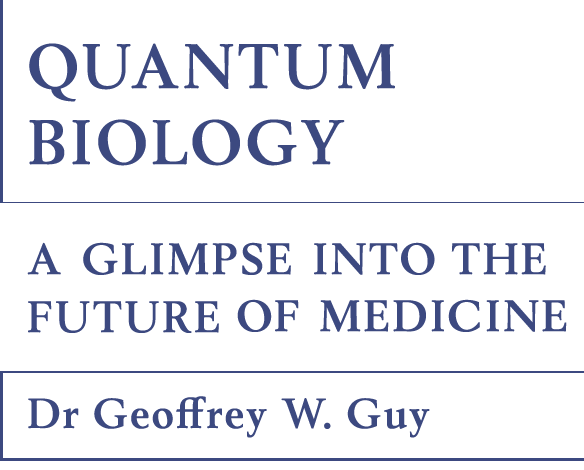
- About Geoffrey Guy
- List of chapters
- 1 Flatworms and xenobots
- 2 Beyond neurons: quantum effects in the brain
- 3 The ghost in the machine
- 4 Inflammation and equilibrium
- 5 The light fantastic
- 6 Lessons from the pandemic
- 7 Reassessing the causes of cancer
- 8 Energy, information and light
- 9 Before the origins of life
- 10 Unravelling the double helix
- 11 The computer in our cells
- 12 Space: the quantum frontier?
- 13 The quantum fractal
- 14 The path to mainstream
- Glossary
- Buy the book



5
The light fantastic
This page provides online resources relating to Chapter 5 of Quantum Biology: A Glimpse into the Future of Medicine. Read a chapter extract, or scroll down to access figures and terminology, additional resources published by The Guy Foundation, and a list of further reading.
Name of the Chapter
Subheading
I have long held the view that the best definition of a pharmaceutical is ‘a worthwhile medicine that makes money’. To be worthwhile, it has to satisfy a real, unmet need; and to survive in the marketplace, it has to make money. I think the same analysis applies to any potential therapies based on quantum effects. To make money, you have to ensure that your product will come to market, and to come to market, it has to obtain regulatory approval. This is particularly the case with light therapy, where there are many domestic light-emitting products available in the shops. Proponents of the ‘do-it-yourself’ approach may say, ‘I devised this treatment in my front room and it works very well.’
Our response to that is, ‘It may have worked very well on that particular occasion, but will it work every time?’ Can you guarantee consistency?’ Even though it might be beneficial for the next patient you treat, it doesn’t form part of a programme that will enable that exact same treatment to be given to the next thousand patients. It’s not subject to a regulatory approval. Although we’ve seen many patients benefit from domestic preparations or interventions, the people producing them have been somewhat indulged. They’ve had the luxury of only needing to treat the patients right in front of them. They haven’t offered a solution that any doctor would be able to prescribe for any suitable patient who enters his or her clinic anywhere in the country.
Buy the book here
In his ‘Light and Life’ talk, Niels Bohr addressed one of the fundamental problems facing researchers into quantum physics at that time: particles do not resemble waves and waves do not resemble particles.
Bohr’s solution was that they both exist and both are equally valid ways of thinking about the quantum world. In a particular experiment you might observe one or the other, but you will never observe both. This is not a contradiction, he said; the two forms are complementary to one another.
Stem cells are the body’s most basic building blocks. They are the raw materials from which other cells are generated to perform various functions in the body. Under the right conditions, stem cells can be made to divide and form what are known as daughter cells.
Stem cell therapy uses stem cells to repair diseased or damaged tissue. It is seen as the next big step in organ transplantation because it uses cells rather than donated organs.
Viscosity is the measure of a fluid’s resistance to flow. The higher the viscosity, the more slowly the liquid flows. Syrup and honey, which have high viscosities, are sticky and do not flow easily. Water and alcohol have much lower viscosities and flow much more freely.
The wavelength of light is measured in nanometres (nm) – a nanometre is one billionth of a metre. Only a part of the electromagnetic radiation spectrum is visible to the human eye. This is known as the ‘visible light’ spectrum and it ranges in wavelength from about 380 nm, which is violet, to about 740 nm, which is red.
2021 Autumn Series Proceedings
Seeing the Light: Electromagnetism in the body and its practical application
December 2021
Videos

The Guy Foundation 2024 Autumn Series
Electrical circuits in biology – quantum or classical?
Professor Gregory Scholes, Princeton University

The Guy Foundation 2023 Spring Series
The role of biophotonics and electromagnetic fields in cellular communications and bioenergetics
Dr Rhys Mould, Research Centre for Optimal Health, University of Westminster

The Guy Foundation 2023 Spring Series
Development, visualisation & modulation of bio-photons in living systems
Professor Stanley Botchway and Dr Alasdair Mackenzie, Central Laser Facility, UK Research & Innovation / Science and Technology Facilities Council, Harwell

The Guy Foundation 2023 Spring Series
Cooperative and coherent quantum phenomena in the life sciences
Dr Philip Kurian, Quantum Biology Laboratory, Howard University

The Guy Foundation 2022 Spring Series
Light-matter interactions and the therapeutic perspective
Dr Lise Hébert, Klox Technologies
Professor Gregory Scholes, Princeton University
Brent Vaughan, Cognito Therapeutics

The Guy Foundation 2021 Autumn Series
Roundtable meeting

The Guy Foundation 2021 Autumn Series
Mechanisms of photobiomodulation and application to the brain
Professor Michael Hamblin, University of Johannesburg

The Guy Foundation 2021 Autumn Series
Therapeutic application of light and electromagnetic fields to reduce hyper-inflammation triggered by COVID-19
Professor Margaret Ahmad, Sorbonne University

The Guy Foundation 2020 Autumn Series
What is coherence and how is it harnessed in biology?
Professor Gregory Scholes, Princeton University
Blanche Aguida, Marootpong Pooam, Margaret Ahmad and Nathalie Jourdan, ‘Infrared light therapy relieves TLR-4 dependent hyper-inflammation of the type induced by COVID-19’, Communicative & Integrative Biology 14:1 (2021), doi.org/10.1080/19420889.2021.1965718
Philip Ball, ‘Is photosynthesis quantum-ish?’, Physics World, 10 April 2018, physicsworld.com/a/is-photosynthesis-quantum-ish/
Marootpong Pooam, Blanche Aguida, Soria Drahy, Nathalie Jourdan and Margaret Ahmad, ‘Therapeutic application of light and electromagnetic fields to reduce hyperinflammation triggered by COVID-19’, Communicative & Integrative Biology 14:1 (2021), doi.org/10.1080/19420889.2021.1911413
Harpreet Shinhmar, Chris Hogg, Magella Neveu and Glen Jeffery, ‘Weeklong improved colour contrasts sensitivity after single 670 nm exposures associated with enhanced mitochondrial function’, Scientific Reports 11 (2021), doi.org/10.1038/s41598-021-02311-1
Carol P. Weingarten, P. Murali Doraiswamy and Matthew P. A. Fisher, ‘A new spin on neural processing: quantum cognition’, Frontiers in Human Neuroscience 10 (2016), doi.org/10.3389/fnhum.2016.00541
